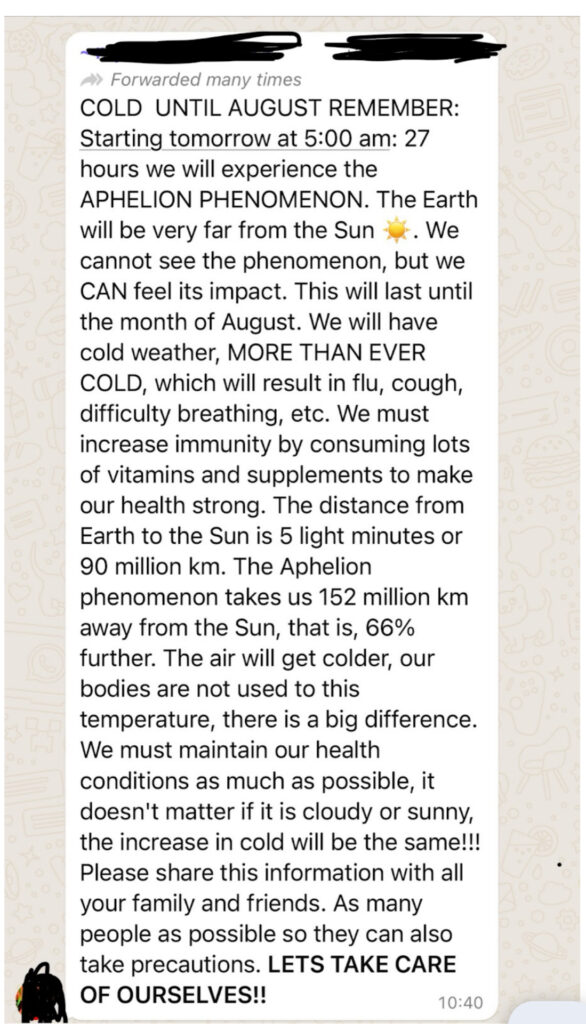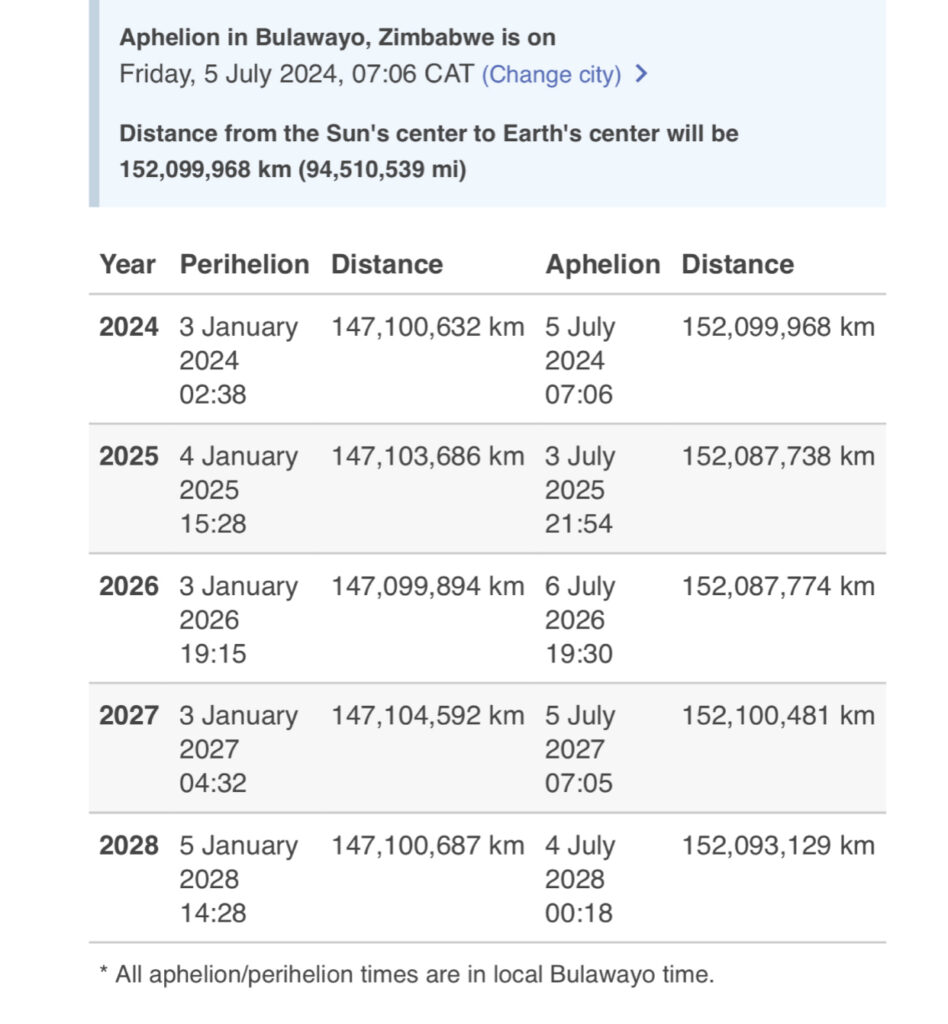CLAIM: When the Earth is at its farthest, we experience lower temperatures here on earth the same way you feel when you sit far from a fireplace
SOURCE: Social Media
VERDICT: False
It’s winter in the Southern Hemisphere and temperatures have been dropping lower and lower. And social media has found a reason for this. Aphelion.
But no, wait. Is Aphelion responsible for seasons and the weather. FactCheckZW took a look at the evidence.
A recent Facebook post reads:
‘APHELION
Are you wondering why it is getting colder and colder day after day? Wonder not, the elliptical characteristic of the Earth’s orbit explains it all. There are two distinct positions of the earth in relation to the sun as it revolves around the sun, one is perihelion and the other is aphelion, these two are the minimum and the maximum proximity of the Earth from the sun. When the Earth is at its farthest, we experience lower temperatures here on earth the same way you feel when you sit far from a fireplace, that position of the sun when it is at its furthest is called aphelion. In 2024, aphelion will be on July 5th, today is 18th June, expect a drop in temperatures as we advance towards aphelion which the average distance between the sun and the Earth will be approximately 152 Million Kms. Brace for colder weeks ahead, dress warm, be weather compliant’.
It is not the only one. Other claims on the same platform are here and here.
A similar message has been forwarded many times on WhatsApp.

Aphelion
This refers to the point in the orbit of a planet, asteroid, or comet at which it is furthest from the sun. It’s opposite is perihelion – which is the point closest to the sun.
The words perihelion and aphelion come from ancient Greek, where peri means close, apo means far, and helios means the Sun. They are used in astronomy to refer to the closest and farthest points of the orbits of any object revolving around the Sun. Together, they are called apsides—the points of least or greatest distance of a celestial object in orbit around another astronomical body. This year’s aphelion will be on the morning of 5 July.
Why does it happen?
According to research, this cycle happens because the Earth’s orbit is not a perfect circle. It has a slight but significant deviation that actually makes Earth’s orbit a slightly squashed oval—that is, an ellipse. The sun doesn’t sit at the center of Earth’s ellipse but instead at one focus, a point along the long, or “major,” axis.
So, does this mean, as claimed, that the temperatures will be very low due to this phenomenon?
No, contrary to these claims, seasons don’t really depend on Earth’s distance from the sun.
For example, when the aphelion happens, temperatures will be very high in the northern hemisphere. Perihelion is in January every year, while aphelion is in July. That means in the Northern Hemisphere they are closer to the sun in winter and farther in summer – the exact opposite of what is being claimed. It is a coincidence that the opposite is true for the Southern Hemisphere.
Seasons don’t really depend on Earth’s distance from the sun. The real reason for the seasons is that Earth’s spin axis is tilted by about 23 degrees, compared with the plane of its orbit—an arrangement that tips Earth’s North Pole toward or away from the sun over the course of a year.
As the earth spins on its axis, producing night and day, it also moves about the sun in an elliptical (elongated circle) orbit that requires about 365 1/4 days to complete. The earth’s spin axis is tilted with respect to its orbital plane. This is what causes the seasons. When the earth’s axis points towards the sun, it is summer for that hemisphere. When the earth’s axis points away, winter can be expected. Since the tilt of the axis is 23 1/2 degrees, the North Pole never points directly at the Sun, but on the summer solstice it points as close as it can, and on the winter solstice as far as it can
Places near the Equator experience little seasonal variation. They have about the same amount of daylight and darkness throughout the year. These places remain warm year-round.

This is not the first time that these claims have appeared. In 2022, AFP Fact Check wrote a fact check debunking similar claims. According to the two experts they interviewed, changes in seasonal temperatures occur because of variations in solar insolation – which is the sun’s energy that reaches Earth – resulting from the tilt of our planet’s rotational axis, and not the distance from the sun.
Conclusion
The claim that ‘when the Earth is at its farthest, we experience lower temperatures here on earth the same way you feel when you sit far from a fireplace’ has been rated as false. It is a common misconception that seasons occur because of Earth’s elliptical orbit around the Sun, with winter occurring when Earth is farthest away from the Sun, and summer when it is closest to it.
However, our planet’s distance from the Sun has little effect on the onset of seasons. In fact, Earth is closest to the Sun, or at its Perihelion, around the Northern Hemisphere’s winter solstice, while it is farthest away from the Sun, or at its Aphelion, around the north’s summer solstice. There is no evidence that aphelion causes flues, coughs and/or difficulties in breathing.








